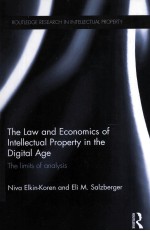

The Law and Economics of Intellectual Property in the Digital AgePDF电子书下载
- 电子书积分:11 积分如何计算积分?
- 作 者:Elkin-Koren
- 出 版 社:Routledge;Taylor & Francis Group [Distributor]
- 出版年份:2012
- ISBN:9780415499088;0415499089
- 页数:287 页
PART Ⅰ Intellectual property, law and economics 1
Introduction 3
1 Introduction to law and economics 14
1.1 The historical roots of law and economics 15
1.2 What is economic analysis of law? 17
1.2.1 What is economics? 18
1.2.2 The economic analysis of law 21
1.3 Shortcomings and challenges of the economic analysis of law 27
1.3.1 The overemphasis on normative analysis and the internal fallacy of law and economics 28
1.3.2 The assumptions of rationality and exogenous preferences 31
1.3.3 Law and economics in a changing global environment 33
1.4 Conclusion 36
2 The rise of intellectual property 38
2.1 The rising significance of intellectual property 38
2.2 What is intellectual property? 40
2.3 Is intellectual property a property right? 42
2.4 The normative sources of intellectual property law 46
2.5 The law and economics of intellectual property 50
PART Ⅱ Normative analysis 55
3 The incentives paradigm 57
3.1 Market failure of public goods as the foundation of intellectual property law 58
3.1.1 Public goodsanalysis 59
3.1.2 Are incentives necessary? 62
3.1.3 Incentives to create - the individual level 65
3.1.4 The need for incentives - the organization level 67
3.1.5 The rise o f alternative modes o f production and monetary incentives 71
3.1.6 Technological change and the need for incentives 77
3.1.7 Summary 79
3.2 Incentives for what? 79
3.2.1 Incentives to create or incentives to produce? 80
3.2.2 Incentives to create or incentives to improve? 83
3.2.3 Incentives to create or incentives to disclose? 85
3.2.4 Summary 86
3.3 Central intervention in the form of intellectual property rights 87
3.3.1 Generating incentives by intellectual property rights 87
3.3.2 Alternative forms of incentives 103
3.3.3 Tailoring intellectual property rights 107
3.4 Conclusion 112
4 The proprietary model of intellectual property 115
4.1 The rise of the proprietary approach in the law and economics literature of IPR 116
4.2 The economic foundations of the proprietary approach: the ‘tragedy of the commons' 118
4.2.1 The theory of Harold Demsetz 118
4.2.2 From the ‘tragedy of the commons' in land to intellectual property 120
4.3 The proprietary paradigm o f intellectual property - sources and main arguments 124
4.3.1 The shift from incentives to proprietary regime as an escape 124
4.3.2 From incentives ex ante to incentives ex post and managing improvements 126
4.3.3 The shift to proprietary model by the founding fathers of law and economics 128
4.3.4 The normative analysis of the proprietary paradigm 131
4.4 A critical view of the proprietary approach 133
4.4.1 Can information be over-consumed? 133
4.4.2 Propertization of the commons and the anti-commons 134
4.4.3 Managing informational commons 136
4.4.4 The proprietary model and large scale collaborations 137
4.4.5 Deconstructing traditional property and the proprietary paradigm of IP 141
4.5 The ‘tragedy of the commons' and positive analysis of intellectual property 143
4.6 Conclusion 145
PART Ⅲ Central intervention and private ordering 147
5 Intellectual property and the rise of private ordering 149
5.1 The rise o f private ordering for governing informational goods 151
5.2 The canonic position of law and economics towards private ordering 155
5.2.1 From social norms to private ordering 155
5.2.2 Private ordering and the limits o f central intervention 156
5.2.3 The contract-as-product approach 157
5.2.4 Implications of the law and economics position 158
5.3 Private ordering: a critical view 159
5.3.1 The contract-as-product re-examined 160
5.3.2 Markets cannot be trusted to secure optimal access to creative works 163
5.3.3 The inconsistency of the law and economics approach 164
5.4 Viral contracts and the new property 165
5.4.1 Is it a contract? 166
5.4.2 Blurring distinctions: private/public,contracts/property 168
5.5 Private ordering and the social web 169
5.5.1 The dual nature of users and platforms 170
5.5.2 Governance 172
5.5.3 The social web -between a market and a community 176
5.5.4 Private ordering and social production 178
5.6 Conclusions 180
6 Intellectual property in the digital era: economic analysis and governance by technology 183
6.1 The rise o f digital locks 184
6.1.1 What are DRMs? 184
6.1.2 Regulation by code and the theory of law 185
6.2 The economic analysis of information in the digital environment 188
6.2.1 Is information still a puhlicgood? 188
6.2.2 Digital networks and the economic analysis of information 190
6.3 The anti-circumvention legal regime 192
6.3.1 Legal background 193
6.3.2 The economic rationale of anti-circumvention legislation 197
6.3.3 The nature of regulation by technology 200
6.4 Post -purchase control and consumer protection 201
6.5 DRMs and competition 204
6.5.1 The virtues of interoperahility 205
6.5.2 Legal impediments to interoperability: the new I PR regime 207
6.5.3 Interoperability and competition in information markets 210
6.5.4 Can the market take care of the problems on its own? 213
6.6 Anti-circumvention legislation and the economics of innovation 216
6.7 Conclusions: designing regulations for regulation by design 219
PART Ⅳ Positive analysis 223
7 A positive analysis of intellectual property law 225
7.1 The pluralist view of legislation 227
7.2 The repuhlican view of legislation 231
7.3 The puhlic choice view of legislation 236
7.4 The intra-national and international dimensions in the positive analysis of IP 244
7.5 Positive analysis of the role of courts 248
References 251
Index 275
- 《FOR PAUL TAYLOR AND ANITA DENCKS PIANO SOLO》JOHN CAGE 1960
- 《厄庇诺米斯 论夜间议事会或论哲人》(古希腊)柏拉图(Plato)著;程志敏,崔嵬编译;刘小枫,甘阳主编 2013
- 《优雅黑白灰 摄影技术流 最超值的摄影技法书》(英)大卫·泰勒 2012
- 《全球化条件下货币当局政策博弈与中国的策略选择》陈元富编 2013
- 《C++ AMP 用Visual C++加速大规模并行计算》(美)格雷戈里,(美)米勒著 2014
- 《税法》财政部注册会计师全国考试委员会办公室编 1996
- 《应用英语教程》宋宜贞主编 2009
- 《中国近代文学大系 1840-1919 第4集 第14卷 诗词集 1》钱仲联主编 1991
- 《中国近代文学大系 1840-1919 第3集 第11卷 散文集 2》任访秋主编 1992
- 《毛泽东传 1893-1949 上》中共中央文献研究室编;主编;金冲及 1996
